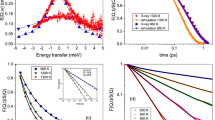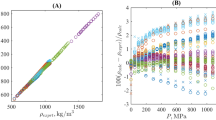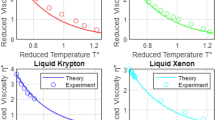Abstract
ANDRADE1 developed a theory of viscosity of liquids based on a model in which the molecules are regarded as executing vibrations essentially similar to those characteristic of the solid state, the chief difference between the solid and the liquid states being that in the latter the amplitudes of the vibrations are so large that molecules make collisions (resulting in ‘temporary unions’) with neighbours at every extreme displacement. His viscosity equation is  where η is the viscosity of the liquid, m the mass of a molecule in the liquid, ν its vibration frequency, and σ the average distance between the centres of the molecules.
where η is the viscosity of the liquid, m the mass of a molecule in the liquid, ν its vibration frequency, and σ the average distance between the centres of the molecules.
This is a preview of subscription content, access via your institution
Access options
Subscribe to this journal
Receive 51 print issues and online access
$199.00 per year
only $3.90 per issue
Buy this article
- Purchase on SpringerLink
- Instant access to full article PDF
Prices may be subject to local taxes which are calculated during checkout
Similar content being viewed by others
References
Andrade, Phil. Mag., 17, 497 (1934).
Osida, Proc. Phys. Math. Soc. Japan, 21, 353 (1939).
Bridgman, Proc. Amer. Acad. Sci., 59, 141 (1923–24).
Mohanty, Curr. Sci., 17, 148 (1948).
Macleod, Trans. Farad. Soc., 21, 160 (1925–26).
Author information
Authors and Affiliations
Rights and permissions
About this article
Cite this article
MOHANTY, S. A Relationship between Heat Conductivity and Viscosity of Liquids. Nature 168, 42 (1951). https://doi.org/10.1038/168042a0
Issue date:
DOI: https://doi.org/10.1038/168042a0
This article is cited by
-
Geometric similitude concept and Redlich–Kwong equation of state to predict thermal conductivity of choline chloride class of deep eutectic solvent
Chemical Papers (2024)
-
Solvation Engineering via Fluorosurfactant Additive Toward Boosted Lithium-Ion Thermoelectrochemical Cells
Nano-Micro Letters (2024)
-
A review on the thermal conductivity of deep eutectic solvents
Journal of Thermal Analysis and Calorimetry (2023)
-
Thermal Conductivity of Ionic Liquids: Recent Challenges Facing Theory and Experiment
Journal of Solution Chemistry (2022)
-
3D-printed silica with nanoscale resolution
Nature Materials (2021)



